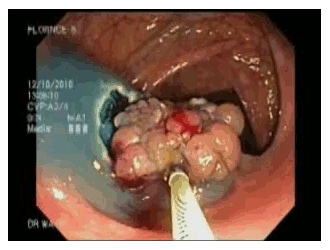 |
 |
|
 |
|
 |
||||||||||||||||||||||||||||||||||||
 |
 |
|||
|
I. The Nakao SpiderNet™ is distributed by CONMED Endoscopic Technologies.
The SpiderNet is a retrieval net utilizing a delicately handmade pouch specially tethered to the inner wall of the catheter to enable its sliding up and down the snare for proper positioning around the polypoid specimen. See the tether below: it is a blue line inside the catheter enabling the net to slide up and down the snare so that the delicate specimen is not mined. II. The Nakao Cautery Retrieval Snare (SNET™) is a double lumen snare that houses a regular cautery snare in one lumen, and the retrieval basket in another. The specially designed and patented handle enables the cautery snare to first be ejected to resect the polyp in the usual fashion. After the polyp is severed, without having to remove the catheter from the working channel of the endoscope, the retrieval net is ejected to retrieve the specimen. The fine retrieval net cradles the delicate specimen so that it may be safely delivered to the pathologist. 
Patented handle for the SNET for respective actuation of the cautery snare followed by the net. Click on picture below to view video of complex polypectomy performed by Dr. Jerome Waye, using the Nakao SNET™ Click on picture to view SNET polypectomy III. The Nakao Single Lumen Cautery Retrieval Snare cuts and retrieves the polyp in a single maneuver. This device combines two loops constructed in a coplanar configuration. The same delicate net described above is attached to the lager of the two loops, while the smaller, inner loop constitutes the cutting wire. The polyp is captured, cautery is applied, and the severed polyp falls into the net. Thus, both cutting and retrieval occur simultaneously, eliminating the polyp chase altogether. Both cautery snares and retrieval nets come in Maxi, Midi, and Mini sizes. 

The entire Nakao Snare™ Line was invented in order to address the problem of the lost polyp syndrome. Colonic polyps, precursors to colon cancer, are removed during a colonoscopy. Resected with a cautery snare, they often roll into the colon necessitating a polyp search in order to retrieve the specimen for pathologic evaluation. The rate of lost polyps is 10-15% in the best of hands, a problem that is quite concerning because the treatment for a cancerous polyp differs significantly from that of a benign one. It is therefore crucial for the patient that every polyp be retrieved. Because it is so important to examine every polyp for cancer cells, the physician must often engage in a difficult and time-consuming polyp chase. The additional time spent in search of the lost polyp adds to the procedure increases risk and patient discomfort. In the worst case the polyp is never found, and the prognosis and proper management of the patient remain uncertain.
Issued Patents |
||||
|
ConMed Endoscopic Technologies |
|
Copyright © Granit Medical Innovations, LLC 2017 |


